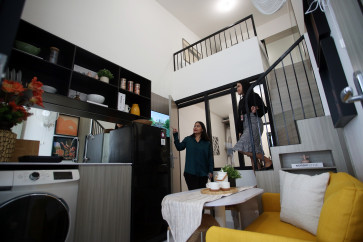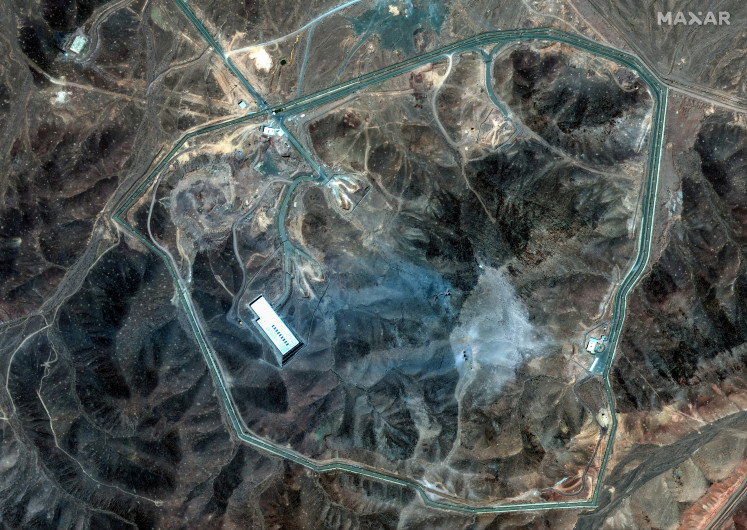Popular Reads
Top Results
Can't find what you're looking for?
View all search resultsPopular Reads
Top Results
Can't find what you're looking for?
View all search resultsNorwegian salmon & the sushi 'revolution'
Fresh favorite: Sushi has become the most popular takeaway lunch in Norway
Change text size
Gift Premium Articles
to Anyone
 Fresh favorite: Sushi has become the most popular takeaway lunch in Norway.(Photo courtesy of Norges sjomatriad/Marius Fiskum)" border="0" height="341" width="512">Fresh favorite: Sushi has become the most popular takeaway lunch in Norway.(Photo courtesy of Norges sjomatriad/Marius Fiskum)
Fresh favorite: Sushi has become the most popular takeaway lunch in Norway.(Photo courtesy of Norges sjomatriad/Marius Fiskum)" border="0" height="341" width="512">Fresh favorite: Sushi has become the most popular takeaway lunch in Norway.(Photo courtesy of Norges sjomatriad/Marius Fiskum)It was an afternoon joy ride by boat along a fjord surrounded by picturesque snowy mountains in Skjervoy, three hoursâ bus-and-ferry travel east of Tromso, Norwayâs gateway to the Arctic.
Officially, it was spring but the temperature had dipped to 2 degrees Celsius and the gusting wind seeped into oneâs bones.
Skjervoy is a dreamy little fishing village in Troms county with a population of 2,300 plus, so few it is comparable to the population of a neighborhood unit in Greater Jakarta.
After half an hour or so, the boat slowed down and approached a large vessel anchored in the middle of a salmon fish-cage complex.
A dozen people left the boat and climbed aboard the vessel, which functions as a control station for the 12 giant salmon cages that make up the modern fish farm run by one of Norwayâs largest multinational salmon farmers.
In Northern Norway, where fish farming is concentrated, salmon farming sites easily accessible from the sea have become tourist attractions, too. The fish cages that look like giant rings in the cold fjord water are a showcase of salmonâs economic and environmental sustainability.
Fishing salmon, cod, trout, halibut and other wild fish from the pristine Norwegian waters has long been an international business.
Norwayâs cold, fast-flowing clean seawater in its numerous fjords creates an ideal environment for aquaculture. The country is the main producer of Atlantic salmon and is the worldâs second-largest seafood exporter after China.
Each giant conical cage, which stretches 45 meters from the top to the end tip suspended halfway to the bottom of the sea, holds between 90,000 and 150,000 salmon. From the multi-decked station, everything in the cage is monitored and controlled 24 hours a day.
Fresh favorite: Sushi has become the most popular takeaway lunch in Norway.(Photo courtesy of Norges sjomatriad/Marius Fiskum) It was an afternoon joy ride by boat along a fjord surrounded by picturesque snowy mountains in Skjervoy, three hours' bus-and-ferry travel east of Tromso, Norway's gateway to the Arctic. Officially, it was spring but the temperature had dipped to 2 degrees Celsius and the gusting wind seeped into one's bones. It pumps out the fish feed and the computers make sure that the salmon have already eaten enough during a feeding session and that little uneaten feed goes to waste to be consumed by wild fish. The crew monitors everything from adequacy of oxygen, fish health and water temperature.
Skjervoy is a dreamy little fishing village in Troms county with a population of 2,300 plus, so few it is comparable to the population of a neighborhood unit in Greater Jakarta.
After half an hour or so, the boat slowed down and approached a large vessel anchored in the middle of a salmon fish-cage complex.
A dozen people left the boat and climbed aboard the vessel, which functions as a control station for the 12 giant salmon cages that make up the modern fish farm run by one of Norway's largest multinational salmon farmers.
In Northern Norway, where fish farming is concentrated, salmon farming sites easily accessible from the sea have become tourist attractions, too. The fish cages that look like giant rings in the cold fjord water are a showcase of salmon's economic and environmental sustainability.
Fishing salmon, cod, trout, halibut and other wild fish from the pristine Norwegian waters has long been an international business.
Norway's cold, fast-flowing clean seawater in its numerous fjords creates an ideal environment for aquaculture. The country is the main producer of Atlantic salmon and is the world's second-largest seafood exporter after China.
Each giant conical cage, which stretches 45 meters from the top to the end tip suspended halfway to the bottom of the sea, holds between 90,000 and 150,000 salmon. From the multi-decked station, everything in the cage is monitored and controlled 24 hours a day. 
Several employees patrol the farm to do the jobs that machines cannot perform, such as repairs to the net and the collection of dead fish.
Aware of the need for sustainability, which would be impossible to maintain if the country relied on wild salmon, the Norwegians made aquaculture a serious business 1970s to meet the soaring demand for premium salmon. Hence, Norway has earned its reputation as the motherland of salmon farming.
'It all began with primitive technology,' remembered Jon Erik Steenslid, a senior marketing official with the Norwegian Seafood Council.
Aquaculture became a burgeoning industry as more multinational enterprises invested in the business as the international market demand kept rising. And the export values rose steadily, increasing from US$5 billion in 1990 to $13.2 billion in 2000 and $32.8 billion in 2010, and 40 billion in 2013, according to the Norwegian Seafood Federation statistics.
Today, seafood exports are Norway's third-largest foreign exchange earner after oil and gas and mining machinery.
Salmon and other fish products are shipped to more than 100 countries, including Indonesia, where a kilo of salmon fillet fetches a whopping Rp 600,000 ($51) ' Rp 700,000 at supermarkets, making it a most pricey fish. And that's why salmon is available only at upscale hotels and restaurants in major cities. In its land of origin, the price is anything between $7 - $10 a kilo.
Salmon is on the menu that every waiter gives you in a restaurant in Norway, maybe it's just as important as chicken is in an Indonesian restaurant. Norwegians can tell you the long list of health benefits you can enjoy from the big fish's pink meat.
Norwegians pride themselves on cooking salmon as a tradition inherited from their ancestors and it is a culture they cherish. Salmon cooking is an art they hand down to their offspring. They even love to share it with the world.
One seafood restaurant in Tromso, Skarven Culinary Theater, holds salmon-cooking demonstrations for its patrons. The restaurant's large kitchen has the setting of a mini sports stadium, where guests closely watch master chef Joakim Kvam act as a cooking instructor, showing you how to slice a salmon and make fillets out of it before he gives you the chance to take a hand at the fishy job.
In Oslo, you can learn how to cook salmon the Norwegian way from native chefs at the Kulinarisk Akademi. Here, chefs teach you not only how to cook salmon but also how to check the fish's freshness and how to treat its tender flesh.
The 'academy' is especially hectic during weekends and holidays when people in groups gather for brief courses on salmon cooking and they can enjoy the all-salmon meals they prepare for their dinner.
Anette Sorlie, quality manager of Leroy Seafood which produces sushi with modern Japanese technology in Kalbakken, Oslo, told a story of how sushi had revolutionized the salmon industry in Norway after the Japanese became addicted to the fleshy fish imported from Norway in 1984. After that, salmon largely replaced the traditional locally sourced tuna as sushi and sashimi fillings.
Leroy set up Sjomathuset, or House of Seafood, this March with Norway's largest supermarket group NorgesGruppen as its sole retailer. The plant produces fresh and chilled seafood as well as fresh sushi. Touted as a state-of-the-art facility, it boasts a capacity of 8-10,000 tons and 20 million pieces of sushi.
Obviously, sushi is equally as tasty to Europeans, especially Norwegians, where fewer and fewer diners struggle with chopsticks. Nowadays, you can easily find sushi at restaurants throughout Norway.
'In fact, sushi is now the number one take-away food in Norway,' Sorlie said.
Responding to the growing popularity of sushi and sashimi, Leroy began a sushi and sashimi venture. Using modern Japanese technology it produces 25,000 boxes every week of the meals for the growing local market.
Norway sees Indonesia, where sushi has also been gaining popularity, as a promising market for its Atlantic salmon thanks to the growing middle-class population who believe in the health benefits of consuming the fish.
While most of the salmon goes to Japan, Norway is campaigning to increase its market share in East Asia, such as in Singapore, China, Malaysia and Indonesia.
The writer recently visited Norway at the invitation of the Norwegian Seafood Council.
Your Opinion Matters
Share your experiences, suggestions, and any issues you've encountered on The Jakarta Post. We're here to listen.
Thank You
Thank you for sharing your thoughts. We appreciate your feedback.
Share options
Quickly share this news with your network—keep everyone informed with just a single click!
Gift Premium Articles
to Anyone
Share the best of The Jakarta Post with friends, family, or colleagues. As a subscriber, you can gift 3 to 5 articles each month that anyone can read—no subscription needed!
Continue in the app
Get the best experience—faster access, exclusive features, and a seamless way to stay updated.









